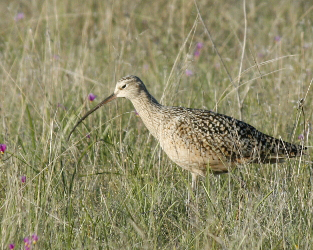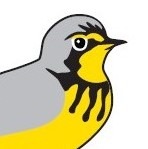By Dr. David Bradley, British Columbia Program Manager, Bird Studies Canada

Long-billed Curlew Photo: Cayla Naumann
Long-billed Curlews are arguably the most stately-looking of all the curlews, and stand as a symbol of the grassland landscapes that have sustained humans for millennia. Unfortunately, our relationship with curlews is fraying because we have intensified our agriculture practices to feed our growing population. Currently, over half of the species in the Numeniini family (which includes curlews, godwits, and some other large waders) are of global conservation concern, making it one of the most threatened bird families in the world!
World Curlew Day (April 21) is an opportune moment to celebrate these shorebirds, and highlight some of the causes of their decline. The hope is that we can reverse the decline of these magnificent birds through research, education, and outreach, so that they continue to be a part of the landscape we share with them.
Bird Studies Canada is doing our part to help out. We are investigating the apparent decline of Long-billed Curlews in Canada by tracking them throughout their life cycles – at their breeding sites and non-breeding grounds, and along their migration routes in between. In 2017, we tagged seven birds with satellite transmitters at the Skookumchuck Prairie Important Bird and Biodiversity Area in the eastern Kootenay mountains of British Columbia. After fledging their young in June, the curlews migrated through Idaho, eastern Washington State, and Oregon before settling for the winter in the Central Valley of California, over 1500 km away. One bird flew all the way to the Mexican border near Mexicali (1800 km from BC) to spend the non-breeding period! It’s also interesting to note the disparate migration routes they took, with some staging for over 40 days in seasonal wetlands and irrigated fields to refuel on their migration.
We are learning some truly amazing things about these birds! And the more we know, the better equipped we are to guide effective conservation action.
World Curlew Day (April 21) is an opportune moment to celebrate these shorebirds, and highlight some of the causes of their decline. The hope is that we can reverse the decline of these magnificent birds through research, education, and outreach, so that they continue to be a part of the landscape we share with them.
Bird Studies Canada is doing our part to help out. We are investigating the apparent decline of Long-billed Curlews in Canada by tracking them throughout their life cycles – at their breeding sites and non-breeding grounds, and along their migration routes in between. In 2017, we tagged seven birds with satellite transmitters at the Skookumchuck Prairie Important Bird and Biodiversity Area in the eastern Kootenay mountains of British Columbia. After fledging their young in June, the curlews migrated through Idaho, eastern Washington State, and Oregon before settling for the winter in the Central Valley of California, over 1500 km away. One bird flew all the way to the Mexican border near Mexicali (1800 km from BC) to spend the non-breeding period! It’s also interesting to note the disparate migration routes they took, with some staging for over 40 days in seasonal wetlands and irrigated fields to refuel on their migration.
We are learning some truly amazing things about these birds! And the more we know, the better equipped we are to guide effective conservation action.

